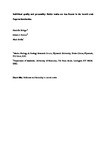Individual quality and personality: bolder males are less fecund in the hermit crab<i>Pagurus bernhardus</i>
| dc.contributor.author | Bridger, D | |
| dc.contributor.author | Bonner, SJ | |
| dc.contributor.author | Briffa, Mark | |
| dc.date.accessioned | 2015-10-21T13:10:13Z | |
| dc.date.available | 2015-10-21T13:10:13Z | |
| dc.date.issued | 2015-03-22 | |
| dc.identifier.issn | 0962-8452 | |
| dc.identifier.issn | 1471-2954 | |
| dc.identifier.other | ARTN 20142492 | |
| dc.identifier.uri | http://hdl.handle.net/10026.1/3684 | |
| dc.description.abstract |
<jats:p>One explanation for animal personality is that different behavioural types derive from different life-history strategies. Highly productive individuals, with high growth rates and high fecundity, are assumed to live life at a fast pace showing high levels of boldness and risk taking, compared with less productive individuals. Here, we investigate among-individual differences in mean boldness (the inverse of the latency to recover from a startling stimulus) and in the consistency of boldness, in male hermit crabs in relation to two aspects of life-history investment. We assessed aerobic scope by measuring the concentration of the respiratory pigment haemocyanin, and we assessed fecundity by measuring spermatophore size. First, we found that individuals investing in large spermatophores also had high concentrations of haemocyanin. Using doubly hierarchical-generalized linear models to analyse longitudinal data on startle responses, we show that hermit crabs vary both in their mean response durations and in the consistency of their behaviour. Individual consistency was unrelated to haemocyanin concentration or spermatophore size, but mean startle response duration increased with spermatophore size. Thus, counter to expectations, it was the most risk-averse individuals, rather than the boldest and most risk prone, that were the most productive. We suggest that similar patterns should be present in other species, if the most productive individuals avoid risky behaviour.</jats:p> | |
| dc.format.extent | 20142492-20142492 | |
| dc.format.medium | ||
| dc.language | en | |
| dc.language.iso | eng | |
| dc.publisher | The Royal Society | |
| dc.subject | fecundity | |
| dc.subject | boldness | |
| dc.subject | personality | |
| dc.subject | consistency | |
| dc.subject | intraindividual variation | |
| dc.subject | predictability | |
| dc.title | Individual quality and personality: bolder males are less fecund in the hermit crab<i>Pagurus bernhardus</i> | |
| dc.type | journal-article | |
| dc.type | Journal Article | |
| plymouth.author-url | https://www.webofscience.com/api/gateway?GWVersion=2&SrcApp=PARTNER_APP&SrcAuth=LinksAMR&KeyUT=WOS:000350349100006&DestLinkType=FullRecord&DestApp=ALL_WOS&UsrCustomerID=11bb513d99f797142bcfeffcc58ea008 | |
| plymouth.issue | 1803 | |
| plymouth.volume | 282 | |
| plymouth.publication-status | Published | |
| plymouth.journal | Proceedings of the Royal Society B: Biological Sciences | |
| dc.identifier.doi | 10.1098/rspb.2014.2492 | |
| plymouth.organisational-group | /Plymouth | |
| plymouth.organisational-group | /Plymouth/Faculty of Science and Engineering | |
| plymouth.organisational-group | /Plymouth/Faculty of Science and Engineering/School of Biological and Marine Sciences | |
| plymouth.organisational-group | /Plymouth/REF 2021 Researchers by UoA | |
| plymouth.organisational-group | /Plymouth/REF 2021 Researchers by UoA/UoA04 Psychology, Psychiatry and Neuroscience | |
| plymouth.organisational-group | /Plymouth/Research Groups | |
| plymouth.organisational-group | /Plymouth/Research Groups/Marine Institute | |
| plymouth.organisational-group | /Plymouth/Users by role | |
| plymouth.organisational-group | /Plymouth/Users by role/Academics | |
| plymouth.organisational-group | /Plymouth/Users by role/Researchers in ResearchFish submission | |
| dc.publisher.place | England | |
| dc.rights.embargodate | 2016-03-22 | |
| dc.rights.embargodate | 2016-03-22 | |
| dc.identifier.eissn | 1471-2954 | |
| dc.rights.embargoperiod | 12 months | |
| rioxxterms.versionofrecord | 10.1098/rspb.2014.2492 | |
| rioxxterms.licenseref.uri | http://www.rioxx.net/licenses/under-embargo-all-rights-reserved | |
| rioxxterms.type | Journal Article/Review |


